
“They had colcannon, and the funniest things were found in it — tiny dolls, mice, a pig made of china, silver sixpences, a thimble, a ring, and lots of other things. After supper was over all went into the big play-room, and dived for apples in a tub of water, fished for prizes in a basin of flour; and then there were games –â€
— Trant, “Hallowe’en in Ireland†from “The Book of Hallowe’en†by Ruth Edna Kelley (1919)
[I]’ll use any excuse to focus on two of my favorite subjects: Halloween and Ireland.
Like me, Halloween has roots in Ireland. For it was the Celts (of Ireland, Scotland, Wales, etc.) who originated Halloween, with the festival of Samhain, the “death†of the sun. Through the years it was considered a powerful year’s end of sacrifice and ritual, evolving into a celebration honoring the harvest and the spirit world in a shadowy time of bonfires, feasting, games and superstition.
I discovered in Ruth Edna Kelly’s marvelous little tome “The Book of Hallowe’en†(1919), that you can’t sling a black cat without hitting a Halloween superstition. There are tons of them. The power of divination was considered to be its strongest, and it was a ripe time to predict future husbands and births and deaths and illness and wealth. People practiced rituals of walking backwards through cabbage patches and checking the fireplace hearth for footprints — and which direction they were going — in the ashes.
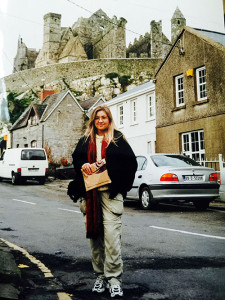 In Ireland, it was a time full of ghosts, goblins, fairies and the legend of Jack O’ Lantern, said to be a real fellow who was stingy and inhospitable. Because of his practical jokes, he was locked out of hell and condemned to walk the earth until judgement day with a lantern lighting his way.
In Ireland, it was a time full of ghosts, goblins, fairies and the legend of Jack O’ Lantern, said to be a real fellow who was stingy and inhospitable. Because of his practical jokes, he was locked out of hell and condemned to walk the earth until judgement day with a lantern lighting his way.
Edible Irish Halloween traditions include colcannon (a mash of potatoes, cabbage and onions) and something called barmbrack, a fruity bread. Of late, I have been more curious of this creation, in Irish called “barin breac†or “speckled bread.†In Kelley’s book, she describes a cake or “mould of flour,†in which the Irish baked in charms that were considered predictors of future events — for example, a coin foretold of wealth; a thimble indicated one would never marry; a piece of wood meant death within the year.
I don’t remember seeing barmbrack when I spent Halloween in Ireland years ago, but I wasn’t looking for it then (I do remember gobbling a tureen of steaming, hearty colcannon). My Halloween adventure began after I had just run a marathon in Dublin and decided to stay and wander. On Halloween, I landed in County Tipperary, in a little burg that sits in the shadow of a splendid old medieval fortress called the Rock of Cashel.
 For all of Ireland’s deep historic connection to Halloween, I found when I was there, the holiday was seemingly understated — not many pumpkins or lights or decorations or even costumes. Despite this, I still had my eerie moments that eve that felt decidedly Halloween. First, I became locked inside a walled garden at the Cashel Palace Hotel. At dusk, I walked inside the high-walled area, heard a click behind me and discovered the gate would not open. No worry. Two delightful Irish ladies walked in and as I yelled at them, they also let the gate shut behind them. I was in good company, and we did get out.
For all of Ireland’s deep historic connection to Halloween, I found when I was there, the holiday was seemingly understated — not many pumpkins or lights or decorations or even costumes. Despite this, I still had my eerie moments that eve that felt decidedly Halloween. First, I became locked inside a walled garden at the Cashel Palace Hotel. At dusk, I walked inside the high-walled area, heard a click behind me and discovered the gate would not open. No worry. Two delightful Irish ladies walked in and as I yelled at them, they also let the gate shut behind them. I was in good company, and we did get out.
Secondly, though I did not see many trick-or-treaters about, I was accosted by two teenage boys while I was “out on the town†in Cashel. They wore weird, nondescript orange masks, too small for their faces, but covering them enough so they were unidentifiable,and chimed in unison: “It’s Halloween — give me some money! It’s Halloween — give me some money!†I threw some Irish coin at them and they let me be. It was somewhat unsettling, but in another time of place, it would have been more so.
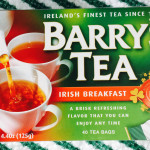 Since my Halloween in Ireland, I’ve tried to practice some ancient Celtic rituals, including one year carving a Jack O’ Lantern from a turnip (which was what was first used instead of pumpkins). Making a Jack O’ Lantern from a turnip is about like getting blood from one, but I did it, and as the candle inside it heated the little fellow, it reeked like no one’s business.
Since my Halloween in Ireland, I’ve tried to practice some ancient Celtic rituals, including one year carving a Jack O’ Lantern from a turnip (which was what was first used instead of pumpkins). Making a Jack O’ Lantern from a turnip is about like getting blood from one, but I did it, and as the candle inside it heated the little fellow, it reeked like no one’s business.
As for barmbrack, I had long wanted to try it, and last year was drawn to a recipe that included black tea as a steeping agent for the dried fruit within (which caused the “specklesâ€). Barmbrack is usually a slightly sweet, dark soda-type bread baked in a cake round or loaf pan.
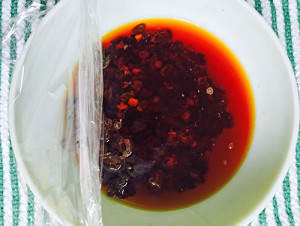 Over the recent days I prepared to make my brack (including picking up a box of Barry’s Tea, imported from Ireland), I discovered how much I loved saying it…“BRAAAAAAACK†(much to the annoyance of those around me). It made me think of the noises parrots make, and then I remembered the strange call of the Jackdaws — Irish crows — as they swirled above the Rock of Cashel.
Over the recent days I prepared to make my brack (including picking up a box of Barry’s Tea, imported from Ireland), I discovered how much I loved saying it…“BRAAAAAAACK†(much to the annoyance of those around me). It made me think of the noises parrots make, and then I remembered the strange call of the Jackdaws — Irish crows — as they swirled above the Rock of Cashel.
The recipe I used called for steeping the fruit (I chose raisins, currants, dates and cherries) in black tea that had cooled. I decided a better steeping would come from pouring the still hot tea over the fruit and letting it sit for a couple of hours.
 A “well†is made in a simple combination of dry ingredients — including flour, brown sugar, baking soda, cinnamon, cloves and nutmeg. An egg, milk and melted butter are blended with the drained, tea-plumped fruit and are put in the well. All is mixed just until a dough forms.
A “well†is made in a simple combination of dry ingredients — including flour, brown sugar, baking soda, cinnamon, cloves and nutmeg. An egg, milk and melted butter are blended with the drained, tea-plumped fruit and are put in the well. All is mixed just until a dough forms.
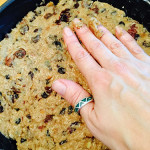 The dough is then patted into the pan. Now for the charm, which was not hard to decide upon. Given the options of a matchstick (foretelling of a beating by a spouse), a piece of cloth (forecasting poverty), or a dried bean (spinsterhood) or even a ring (marriage, not for me), there seemed only one option — the coin, for wealth. Why the hell would you put those other items in, unless for fun…for others.
The dough is then patted into the pan. Now for the charm, which was not hard to decide upon. Given the options of a matchstick (foretelling of a beating by a spouse), a piece of cloth (forecasting poverty), or a dried bean (spinsterhood) or even a ring (marriage, not for me), there seemed only one option — the coin, for wealth. Why the hell would you put those other items in, unless for fun…for others.
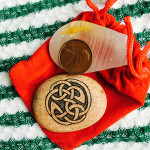 I found an old penny that was with a few real Irish trinkets (like my worry stone) in a little basket. Seemed the proper coin to wrap in parchment and press into the bread. Perhaps there was a wee bit of mis-magic being drafted in my own kitchen, but I figured, we are supposed to be the master of our fates.
I found an old penny that was with a few real Irish trinkets (like my worry stone) in a little basket. Seemed the proper coin to wrap in parchment and press into the bread. Perhaps there was a wee bit of mis-magic being drafted in my own kitchen, but I figured, we are supposed to be the master of our fates.
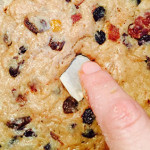 I covered the coin over with the dough, leaving no clue it was there (it was also baked in a pan with no handles, so I would have even less of a landmark of where it was).
I covered the coin over with the dough, leaving no clue it was there (it was also baked in a pan with no handles, so I would have even less of a landmark of where it was).
Just before the baking finished, I brushed the bread with warm honey. Between the tea, honey and spices, a heady warm aroma haunted my kitchen that overcast afternoon. Irish magic, indeed.
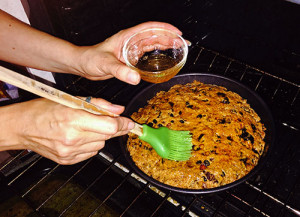 As I write this, I know readers will be doubters (and doubters doubt), that by the time I sliced that bread, I did not know where the penny had landed and yet, as I removed that first slice for the barmbrack’s photo closeup, there it was. I knew I would hit it eventually, but I considered it extra lucky that it was revealed upon first cutting. I would accept the charm and its foretelling, even though I had brought it forth myself. I remain superstitiously optimistic.
As I write this, I know readers will be doubters (and doubters doubt), that by the time I sliced that bread, I did not know where the penny had landed and yet, as I removed that first slice for the barmbrack’s photo closeup, there it was. I knew I would hit it eventually, but I considered it extra lucky that it was revealed upon first cutting. I would accept the charm and its foretelling, even though I had brought it forth myself. I remain superstitiously optimistic.
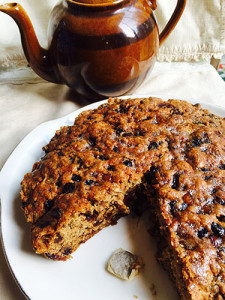 I realized I brought about another bit of magic that day, by conjuring Irish memories and by baking. The barmbrack is not particularly attractive, and I did not expect it to taste as good as it did. Moist and tender, gently spiced, the sweet fruit carries with it just a subtle spot of that black Irish breakfast tea, and the honey finish was just right.
I realized I brought about another bit of magic that day, by conjuring Irish memories and by baking. The barmbrack is not particularly attractive, and I did not expect it to taste as good as it did. Moist and tender, gently spiced, the sweet fruit carries with it just a subtle spot of that black Irish breakfast tea, and the honey finish was just right.
A coin’s a coin, and I was happy to have it (“It’s Halloween — give me some money!â€), but a good recipe, now, that’s money in the bank!
Irish Barmbrack
From Saveur magazine (www.saveur.com)
Serves 6 to 8
2 cups black tea, cooled
3â„4 cup raisins
1â„2 cup dried currants, cranberries, or cherries
2 tbsp. each candied lemon and orange peel, minced
2 cups flour, plus more
1â„4 cup light brown sugar
2 tsp. baking soda
1 tsp. ground cinnamon
1â„4 tsp. freshly grated nutmeg
1â„4 tsp. ground cloves
6 tbsp. unsalted butter, preferably European-style like Kerrygold or Plugrá, melted, plus more
1â„4 cup whole milk
1 egg, beaten
Assorted charms, wrapped individually in parchment paper
1â„3 cup honey, warmed
Stir tea, raisins, currants, and candied lemon and orange peel in a bowl; cover with plastic wrap and let sit 2 hours, then drain and set aside. Heat oven to 325°. Whisk flour, sugar, baking soda, cinnamon, nutmeg, and cloves in a bowl; make a well in the center. Mix reserved fruit, the butter, milk, and egg in a bowl and add to well; stir until a wet dough forms. Press dough into a greased 8″ cake pan and push charms into dough. Bake until firm, 35–40 minutes. Brush with honey; bake 2 minutes more. Let cool slightly; serve with butter, if you like.
Blogger’s Note: This recipe calls for extra butter and flour, but does not explain why. I assumed it was for buttering and flouring the pan. I used a nonstick pan and just greased it with butter and the bread released perfectly.
